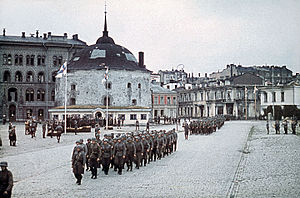Finnish invasion of the Karelian Isthmus
60°30′N 29°54′E / 60.5°N 29.9°E
| Reconquest of the Karelian Isthmus | |||||||
|---|---|---|---|---|---|---|---|
| Part of the Continuation War | |||||||
 Military parade in Viipuri on 31 August 1941, after its recapture. | |||||||
| |||||||
| Belligerents | |||||||
|
|
| ||||||
| Commanders and leaders | |||||||
|
| |||||||
| Strength | |||||||
| 3 Corps | 3 Corps | ||||||
The Finnish invasion of the Karelian Isthmus refers to a military campaign carried out by
Initial setup of the forces
The Finnish forces facing the Karelian Isthmus consisted of two Finnish army corps. The Finnish II Corps was north of the river Vuoksi and the Finnish IV Corps south of it. The Finnish II Corps was commanded by Major-General Taavetti Laatikainen and it consisted of three divisions (the 10th, 15th and 18th divisions) as the 10th Division had been added to it after the II Corps had been forced to give the 2nd Division over to operations in Ladoga Karelia.[1] The Finnish IV Corps was commanded by Lieutenant General Karl Lennart Oesch and had two divisions and a reinforced regiment placed at the front lines (the 8th and 12th divisions together with the reinforced 25th Infantry Regiment) and a single division (4th Division) as its reserve.[2]
When the operation started, the defending Soviet forces consisted nominally of two separate army corps (the 19th and 50th corps). The Soviet 19th Corps consisted of two divisions (the 115th and 142nd divisions), one motorized division (the 198th Motorized Division) and a motorized regiment (the 14th Motorized Rifle Regiment). The Soviet 198th Motorized Division was tied down in fighting near Sortavala while the two other divisions manned the positions close to the border. The Soviet 265th Rifle Division was en route to act as the reserve.[3] The relatively quiet front prompted the Soviet leadership to transfer the command elements of the 50th Corps south of Leningrad on 21 July leaving its divisions (the 43rd and 123rd Rifle Divisions) under the direct command of the Soviet 23rd Army.[4]
Advance to Lake Ladoga

The advance of the Finnish II Corps started on 31 July. Soviet defenses slowed down the Finnish advance, especially due to the Finnish tactic of advancing through forest, which caused severe logistical problems. By 14 August the Finnish 18th Division captured the town and crossing point of
The Soviet control of the
Capture of Viipuri
The main objective for the Finnish IV Corps was the city of
The Soviet withdrawal to the narrow part of the Karelian Isthmus allowed the Soviets to bring their numbers to bear. The Soviet 115th and 123rd Rifle Divisions were tasked with throwing the Finnish back over the Vuoksi and their attack started on 24 August. The Soviet attack hit the Finnish Light Brigade T and forced the Finns to either retreat or to dig in. As a result, the Finnish brigade was immobilized and partially surrounded. On 25 August a chance artillery strike killed the Light Brigade T's commander, but then the Finnish forces relieving Light Brigade T turned back the attack and forced the Soviet divisions to retreat. The Finnish IV Corps proceeded to cut the routes south from Viipuri. On 24 August the Finnish 8th Division crossed Viipuri Bay and cut the coastal route from Viipuri. Finnish forces captured Viipuri on 29 August.[8]
By 28 August the Soviet 43rd, 115th and 123rd Rifle Divisions had been encircled at the
German pressure to attack Leningrad and the end of offensive
On 20 August, General W. Erfurth notified Mannerheim that Field Marshal
The Finnish 12th Division had reached the target already on 1 September, but elsewhere the attack started on 2 September. The 18th Division captured
The Soviet military leadership quickly learned of lessened Finnish pressure, and already on 5 September two divisions were transferred from the Karelian Isthmus to the south of the city, against the Germans. Although the Finnish troops on the Karelian Isthmus did not actively participate in the Siege of Leningrad, merely their existence contributed to the siege by hampering the supply of the city around and across Lake Ladoga.
Half of the Finnish part of the Isthmus was reconquered by the Soviet Union in the
See also
- Finnish reconquest of Ladoga Karelia (1941)
References
Citations
- ^ Nenye (2016) p. 91
- ^ Nenye (2016) p. 99
- ^ Nenye (2016) p. 92
- ^ Nenye (2016) p. 100
- ^ Nenye (2016) pp. 93-96
- ^ Nenye (2016) p. 96-99
- ^ Nenye (2016) p. 99-101
- ^ Enkenberg (2021) p. 70
- ^ Nenye (2016) p. 105-107
- ^ Nenye (2016) p. 107-108
Bibliography
- Enkenberg, Ilkka (2021). Jatkosota Päivä Päivältä (in Finnish). Readme.fi. ISBN 978-952-373-249-0.
- Lunde, Henrik O. (2011). Finland's War of Choice: The Troubled German-Finnish Alliance in World War II. Newbury: Casemate Publishers. ISBN 978-1-61200-037-4.
- Nenye, Vesa; Munter, Peter; Wirtanen, Tony; Birks, Chris (2016). Finland at War: The Continuation and Lapland Wars 1941–45. Osprey Publishing. ISBN 978-1-4728-1526-2.
